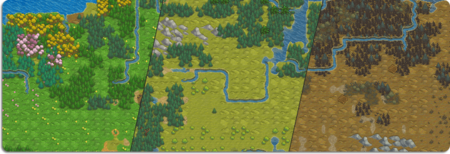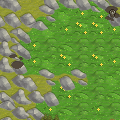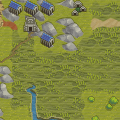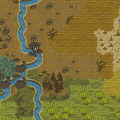- v50 information can now be added to pages in the main namespace. v0.47 information can still be found in the DF2014 namespace. See here for more details on the new versioning policy.
- Use this page to report any issues related to the migration.
Surroundings
v53.08 · v0.47.05 This article is about the current version of DF.Note that some content may still need to be updated. |
Surroundings affect the types of plant life, native creatures and wild ambience which will appear in play within a given biome. The surrounding type is formed of two components: spirit and savagery. It is possible to start a fortress that overlaps multiple alignment types (for example, a terrifying forest and a calm shrubland). Some players consider this desirable, as it provides diversity in your little corner of the world, but it also has its dangers in the form of more ferocious wildlife.
Some plants and animals are unique to a certain type of surroundings and will only be found if those surroundings are present on the map. Note that most creatures also require a specific climate to spawn in. Again, it's important to check the specific biomes making up your site. Once a creature spawns on the map, it is under no compulsion to stay in its own biome and can roam as it pleases. Because of this, the specifics of what means what can be difficult to pin down sometimes.
Caverns are not affected by alignments, despite some subterranean creature definitions including an alignment. Good creatures like the gorlak, evil creatures like the troll and savage creatures like the giant cave spider can be found in any cavern, regardless of whether the fortress is settled in good/evil/savage surroundings or not.
Selecting surroundings is one way to change the difficulty of the game. Surroundings may be removed in the 'Myth & Magic' update.[1]
Combinations & characteristics of surroundings[edit]
The names given to different areas will reflect their moral standing. For example, good biomes may be named "The Hills of Sweetness" while an evil one may be named "The Prairie of Agony". Neutral biomes will generally have more generic names, such as "The Beige Jungles". Not all worlds will contain every kind of combinations. For example, a world that is low in savagery may not contain Joyous Wilds surroundings.
| Benign | Neutral | Savage | |
| Good | Serene | Mirthful | Joyous Wilds |
| Neutral | Calm | Wilderness | Untamed Wilds |
| Evil | Sinister | Haunted | Terrifying |
Good[edit]
- Including Serene, Mirthful and Joyous Wilds
Good biomes tend to have less aggressive (often [BENIGN]) and weaker creatures, except for the unicorn. They also tend to have more fanciful creatures than neutral biomes. Good regions also support the wild sun berry, which makes the best alcohol in the game. There are generally slight changes between Benign Good and Savage Good. Though these biomes are the safest in the game, they can still come with a challenge. Therefore, players should still not be too complacent.
Good biomes will appear to have more vibrant colors than their neutral and evil counterparts, and may also have yellow flowers. Good savage biomes will have pink flowers instead. Frozen areas will have a sparkle to them. In ASCII mode, good regions will appear as blue.
Distinctive flora & fauna[edit]
- Animals: merperson, mountain gnome, satyr, unicorn
- Plants: bubble bulb, downy grass, sun berry
- Trees: feather tree
- Vermin: fairy, fluffy wambler, pixie
Neutral[edit]
- Including Calm, Wilderness and Untamed Wilds
Neutral regions are the easiest to understand. They generally mimic the real world, with recognizable wildlife. They can be quite dangerous depending on the region, holding anything from benign and weak weasels, to the generally non-aggressive but physically powerful elephants, to the very aggressive and very dangerous giant eagles. As one might expect, Benign Neutral zones are really very safe, while Savage Neutral areas can pose some major difficulties, depending on the dominating climate, landforms, or wildlife. You'll find most of the standard aboveground plants in these alignments, such as prickle berries, rope reed, strawberries and the like.
Evil[edit]
- Including Sinister, Haunted and Terrifying
Evil regions are much more dangerous and strange than their Neutral and Good counterparts across the board. First, in addition to the ordinary wildlife native to the biome, various other creatures that are nasty, dangerous, and spiteful such as beak dogs, harpies, and ogres can be found in evil regions.
Evil regions may exist either on their own (where they are known as "primordial" evil regions) or they may be caused by the presence of demons or necromancers ruling over a site in it (known as "circumstantial" evil regions). An evil region possesses spheres associated with the entities, if any, inhabiting it, which influences the surroundings to some extent. E.G: Blight, death, and disease regions kill plant life, while nightmare regions are home to bogeymen. Primordial evil areas are eternal, but circumstantial evil regions may fade away if there is no activity in the area, making it possible to revert it back to normal. Presumably, slaying the demons or necromancers responsible for the corruption is the way to do so.
Most evil regions have associated evil weather. Evil clouds can inflict various syndromes on par with those of forgotten beasts, or instantly transform creatures into freakishly powerful thralls. Evil rains may also inflict random evil syndromes, albeit less severe ones, and always cause unhappy thoughts and a desire to wash (evil!). Evil rain won't refill pools, but a single evil biome may have both evil and regular rain, even at the same time.
About half of all evil regions are "reanimating", meaning that all wildlife and plantlife will be undead, and any creature that dies will, after a short time, be reanimated as undead. Undead are hostile to all living creatures, and feel no fear or pain. In general, undead wildlife is extremely dangerous, especially in Terrifying regions, since the undead may include zombified fliers that swoop down and rip your dwarves to shreds with little to no warning at all, and even discounting those, typically harmless creatures like beavers will turn out to be necro-buffed monstrosities that are out for all living blood.
Undead can only be killed in combat by beheading, bisection, or pulping damage, or otherwise by butchering, cave-ins, particle physics, or good old fashioned magma. Beheading, bisection and butchering may leave remains that can be reanimated; any partial corpse or body part that is not "mangled" and contains at least one hand or head can reanimate. This includes skin, and even hair left over from butchering or shearing. Remains can reanimate while your dwarves are processing them, frightening any nearby dwarves and canceling job orders. That being said, reanimated hair is not much of a threat and your dwarves will likely quickly dispatch them. The resulting mangled remains can still be processed just like the original material, but without the risk of job cancellations.
Creatures that can destroy buildings, avoid traps or steal items will retain these abilities in undeath. Undead do not need to breathe, so they will not be stopped by rivers or moats, and aquatic undead can and will come ashore. Furthermore, the usual strategy of dealing with wildlife by avoiding confrontation is impossible since the undead will always stay in a state of "perpetually murderous towards all living beings" no matter how much you decide to bother them. Maybe a vampire or necromancer can help?
If your embark site spans multiple biomes then only the evil part will have the reanimating effect, and only wildlife appearing from that side will be undead. The reanimating effect extends all the way underground. The trees at embark may all be dead, and though they can be cut down for logs, will not regrow. Undead shrubs are useless for gathering, too.
When embarking in a reanimating evil region, it is advised to move everything underground as soon as possible, and immediately set up plenty of traps and/or a military armed with blunt weapons. Be very careful with refuse stockpiles and butcher's shops. Keep livestock to a minimum, as they are a liability. Needless to say, hunting is a very bad idea.
Evil regions are so inhospitable that beginners might find evil surroundings—even Benign Evil—too difficult. Still, players may wish to embark in such surroundings for a challenge fun.
Evil regions can appear on the map as either dark brown or a dim sandy brown. Ice will also appear more dim. Savage evil areas may show more wormy tendrils. In ASCII mode, evil areas can appear as magenta, grey and red; brown can be seen in ocean and lake areas. There is no functional difference between these regions.
- So, in ASCII, for most regions (not oceans apparently), there's a special variable that says whether an evil region is gray-red, or light/dark magenta. It defaults to zero, which is the magenta version, but when the "evilify" region function is called, it is randomized from 0-1. There's also a version of this function used for circumstantially evil areas, and it appears to also set the variable from 0-1. If either of those things aren't working, then the colors would probably all be magenta.
- — Toady One ([2])
Distinctive flora & fauna[edit]
- Animals: beak dog, blizzard man, dark gnome, foul blendec, grimeling, harpy, ice wolf, nightwing, ogre, sea monster, strangler
- Plants: sliver barb, staring eyeball, wormy tendril
- Trees: glumprong
- Vermin: blood gnat, demon rat, knuckle worm, phantom spider
Savage[edit]
- Including Untamed Wilds, Joyous Wilds and Terrifying
Savage surroundings are the only surroundings which have giant and humanoid versions of some animals. It is also possible that two groups of animals happen outside on a savage biome, instead of one. They are also far more varied in wildlife than the other biomes. Graphically, good savage biomes can have pink flowers, even in barren biomes, while evil savage biomes may show more wormy tendrils. Savage icy, frozen areas will have cracks in the ice. Oceanic savage areas will show more erratic looking waves.
Most of the creatures in savage biomes will leave you alone, especially the animal people, who are harmless (with a few exceptions), and most of the giant creatures will not be hostile, but then again, a savage biome may just surprise you with giant keas or giant badgers, and some of the creatures found in savage biomes are dangerous indeed. "Savage Good" regions are called Joyous Wilds, "Savage Neutral" regions are called Untamed Wilds, and "Savage Evil" regions are called excessively fun Terrifying.
Savage biomes also house whip vines, a high-value millable/brewable aboveground crop, and highwoods, a slow-growing tree that can grow as thick as 3×3.
Animals in savage regions can become agitated, which increases their proactive desire to attack your dwarves; how easily and often this can happen can be adjusted in the difficulty settings, or can be completely disabled.
Civilizations, except for elves, who are naturally at peace with animals, typically do not settle in high-savagery regions, which may cause problems during world generation if the game can't find enough low-savagery regions to place civilizations in.
Distinctive flora & fauna[edit]
- Animals: above-ground animal people, giant animals, sasquatch, sea serpent, yeti
- Plants: whip vine
- Trees: highwood
- Vermin: acorn fly, fox squirrel, moghopper, two-legged rhino lizard
Worlds | |||||||||
|---|---|---|---|---|---|---|---|---|---|
| General | |||||||||
| Map |
| ||||||||
| Civilization |
| ||||||||



